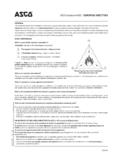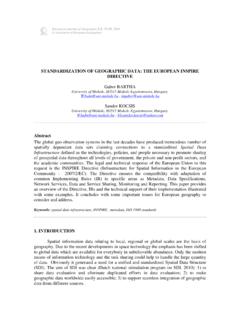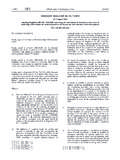Transcription of 1. Name of pharmacopoeia - WHO
1 1 | 2 | 1. Name of pharmacopoeia european pharmacopoeia 36 Member states (Austria, Belgium, Bosnia and Herzegovina, Bulgaria, Croatia, Cyprus, Czech Republic, Denmark, Estonia, Finland, France, Germany, Greece, Hungary, Iceland, Ireland, Italy, Latvia, Lithuania, Luxembourg, Malta, Montenegro, Netherlands, Norway, Poland, Portugal, Romania, Serbia, Slovak Republic, Slovenia, Spain, Sweden, Switzerland, the former Yugoslav Republic of Macedonia , Turkey, United Kingdom), and the european Union. Observers: 23 countries (Albania, Algeria, Argentina, Armenia, Australia, Belarus, Brazil, Canada, China, Georgia, Israel, Kazakhstan, Madagascar, Malaysia, Moldova, Morocco, the Russian Federation, Senegal, Singapore, Syria, Tunisia, Ukraine, the United States of America) and the World Health Organization (WHO).
2 3 | 2. pharmacopoeia referred to in national/regional legislations Several legal texts make the european pharmacopoeia mandatory in Europe: Convention on the Elaboration of a european pharmacopoeia , and amending Protocol (following accession of the european Union), european Union Directives 2001/82/EC and 2001/83/EC, as amended, and 2003/63/EC on medicines for human and veterinary use. These state the legally-binding character of european pharmacopoeia texts for marketing authorisation applications.
3 4 | National/regional legislation includes reference to other national pharmacopoeia (s): Yes The monographs of the european pharmacopoeia shall be applicable to all substances, preparations and pharmaceutical forms appearing in it. In respect of other substances, each Member State may require observance of its own national pharmacopoeia . (Directive 2001/83/EC as amended) regional pharmacopoeia (s): international pharmacopoeia (s): Yes In case where starting and raw materials, active substance(s) or excipient(s) are described neither in the european pharmacopoeia nor in the pharmacopoeia of a Member State, compliance with the monograph of a third country pharmacopoeia can be accepted.
4 In such cases, the applicant shall submit a copy of the monograph accompanied by the validation of the analytical procedures contained in the monograph and by a translation where appropriate. (Directive 2001/83/EC as amended) 5 | 4. Publication of latest edition The 7th edition of the Ph. Eur. has been published in July 2010 (implementation date: 01/2011). A new edition is published every 3 years. 6 | 5. Update frequency 3 supplements per year are published: 7 | 6. For which products does the pharmacopoeia provide specifications?
5 Monographs : Actives substances incl. antibiotics excipients biologicals, blood and plasma derivatives, vaccines and radiopharmaceutical preparations dosage forms, homoeopathic preparations and homoeopathic stocks, herbal drugs, herbal drug preparations and Traditional Chinese Medicines .. 8 | 7. Number of texts included in the pharmacopoeia (1/2) monographs for APIs: approx. 1480 Monographs for excipients: approx. 370 monographs for finished dosage forms: approx. 30 monographs for biologicals: approx.
6 295 general monographs: 22 supplementary texts: approx. 3210 (33 general texts, 258 methods of analysis, 2513 reagents, 26 materials and containers, 1 suture) 9 | 7. Number of texts included in the pharmacopoeia (2/2) Most monographs require at least one reference standard The reference standard underpins the quality standard Established and monitored by the EDQM Laboratory Produced and distributed by the Reference Standards Division 2200 reference standards 10 | 8. Collaboration with and/or being part of a (different) national/regional pharmacopoeia (1/4) Membership: All National Pharmacopoeias of the signatory parties to the Convention are members of the Ph.
7 Eur. (complementarity, no duplication of work). In the member countries of the national pharmacopoeias complement the for texts of interest to one Member State only. Some member countries also re-publish monographs in the national pharmacopoeias 11 | 8. Collaboration with and/or being part of a (different) national/regional pharmacopoeia (2/4) Membership (ctd.): Membership enables states to participate in european pharmacopoeia Commission sessions. Within these sessions, each state is represented by their national delegation consisting of not more than 3 members.
8 On all technical matters delegations cast a vote. The EU decides on behalf of EU member states in all non-technical issues of the european pharmacopoeia . Each member state can also propose national experts for each group of experts or working party. The european Medicines Agency (EMA) participates in the sessions of the Commission and working parties of interest. EDQM participates in relevant committees and working parties at the level of the EMA. In addition, annual meeting are organised between EDQM and National pharmacopoeia Authorities.
9 12 | 8. Collaboration with and/or being part of a (different) national/regional pharmacopoeia (3/4) Observership to the Ph. Eur.: Allows for participation in the scientific work of the european pharmacopoeia Commission. Observers benefit from the european experience in this area and gain access to the work on the quality control of medicines and the methods of analysis used. Examples: Belarus, Brazil, Russia, SFDA, US-FDA, WHO, EDQM observers to : Ph. Int. ICH 13 | 8. Collaboration with and/or being part of a (different) national/regional pharmacopoeia (4/4) Collaboration: Pharmacopoeial Discussion Group: Representatives of 3 Pharmacopoeias: Ph.
10 Eur., JP, USP Mainly retrospective harmonisation of general chapters and of excipients monographs Prospective harmonisation with USP (pilot phase): Elaboration and maintenance of individual monographs on 4 APIs: Rizatriptan benzoate, Montelukast sodium, Celecoxib and Sildenafil citrate, 14 | 9. Publication of harmonized pharmacopoeial texts within the pharmacopoeia If yes, which pharmacopoeia : JP & USP If yes, which type: individual monograph on excipients and general chapters If yes, how many: 28 of the 35 General Chapters and 41 of the 61 excipient monographs of the current work programme have been harmonised.















